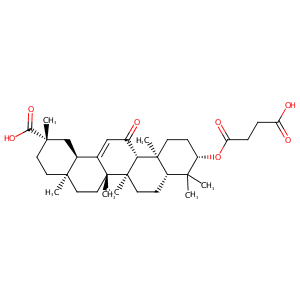Drug Information
| Drug General Information | Top | |||
|---|---|---|---|---|
| Drug ID |
D0L4VR
|
|||
| Former ID |
DNC000388
|
|||
| Drug Name |
Carbenoxolone
|
|||
| Synonyms |
carbenoxolone; 5697-56-3; UNII-MM6384NG73; OBZHEBDUNPOCJG-WBXJDKIVSA-N; MM6384NG73; Carbenoxolone [INN:BAN]; Carbenoxolonum [INN-Latin]; Carbenoxolona [INN-Spanish]; Carbenoxolona; Carbenoxolonum; EINECS 227-174-2; CBO; (2S,4aS,6aR,6aS,6bR,8aR,10S,12aS,14bR)-10-(4-hydroxy-4-oxobutanoyl)oxy-2,4a,6a,6b,9,9,12a-heptamethyl-13-oxo-3,4,5,6,6a,7,8,8a,10,11,12,14b-dodecahydro-1H-picene-2-carboxylic acid; 3beta-Hydroxy-11-oxoolean-12-en-30-saeure hydogensuccinat; 3beta-(3-Carboxypropionyloxy)-11-oxo-olean-12-en-30-saeure
Click to Show/Hide
|
|||
| Drug Type |
Small molecular drug
|
|||
| Indication | Discovery agent [ICD-11: N.A.] | Investigative | [1] | |
| Structure |
 |
Download2D MOL |
||
| Formula |
C34H50O7
|
|||
| Canonical SMILES |
CC1(C2CCC3(C(C2(CCC1OC(=O)CCC(=O)O)C)C(=O)C=C4C3(CCC5(C4CC(CC5)(C)C(=O)O)C)C)C)C
|
|||
| InChI |
1S/C34H50O7/c1-29(2)23-10-13-34(7)27(32(23,5)12-11-24(29)41-26(38)9-8-25(36)37)22(35)18-20-21-19-31(4,28(39)40)15-14-30(21,3)16-17-33(20,34)6/h18,21,23-24,27H,8-17,19H2,1-7H3,(H,36,37)(H,39,40)/t21-,23-,24-,27+,30+,31-,32-,33+,34+/m0/s1
|
|||
| InChIKey |
OBZHEBDUNPOCJG-WBXJDKIVSA-N
|
|||
| CAS Number |
CAS 5697-56-3
|
|||
| PubChem Compound ID | ||||
| PubChem Substance ID |
7886488, 11068138, 11466865, 11467985, 11486450, 14764266, 16767811, 26706622, 43758895, 47291139, 47440262, 48035126, 48334500, 48415693, 51091924, 78326419, 85787318, 103059024, 103590439, 104102199, 113523857, 125311953, 134339830, 134987906, 137254896, 138569897, 152090780, 163875152, 178100972, 179230495, 198987908, 226455625, 250133956
|
|||
| SuperDrug ATC ID |
A02BX01
|
|||
| SuperDrug CAS ID |
cas=005697563
|
|||
| Interaction between the Drug and Microbe | Top | |||
|---|---|---|---|---|
| The Abundace of Studied Microbe(s) Regulated by Drug | ||||
| The Order in the Taxonomic Hierarchy of the following Microbe(s): Eubacteriales | ||||
|
Studied Microbe: Clostridioides difficile
Show/Hide Hierarchy
|
[2] | |||
| Hierarchy | ||||
| Abundance Change | Decrease | |||
| Experiment Method | High-throughput screening | |||
| Description | The abundance of Clostridioides difficile was decreased by Carbenoxolone disodium salt (adjusted p-values: 2.80E-03). | |||
|
Studied Microbe: Clostridium perfringens
Show/Hide Hierarchy
|
[2] | |||
| Hierarchy | ||||
| Abundance Change | Decrease | |||
| Experiment Method | High-throughput screening | |||
| Description | The abundance of Clostridium perfringens was decreased by Carbenoxolone disodium salt (adjusted p-values: 9.87E-06). | |||
| Target and Pathway | Top | |||
|---|---|---|---|---|
| Target(s) | Corticosteroid 11-beta-dehydrogenase 1 (HSD11B1) | Target Info | Inhibitor | [3], [4], [5] |
| KEGG Pathway | Steroid hormone biosynthesis | |||
| Metabolism of xenobiotics by cytochrome P450 | ||||
| Metabolic pathways | ||||
| Chemical carcinogenesis | ||||
| NetPath Pathway | IL1 Signaling Pathway | |||
| FSH Signaling Pathway | ||||
| Pathwhiz Pathway | Steroidogenesis | |||
| Reactome | Glucocorticoid biosynthesis | |||
| WikiPathways | Prostaglandin Synthesis and Regulation | |||
| Metabolism of steroid hormones and vitamin D | ||||
| Glucocorticoid & Mineralcorticoid Metabolism | ||||
| References | Top | |||
|---|---|---|---|---|
| REF 1 | URL: http://www.guidetopharmacology.org Nucleic Acids Res. 2015 Oct 12. pii: gkv1037. The IUPHAR/BPS Guide to PHARMACOLOGY in 2016: towards curated quantitative interactions between 1300 protein targets and 6000 ligands. (Ligand id: 4151). | |||
| REF 2 | Extensive impact of non-antibiotic drugs on human gut bacteria. Nature. 2018 Mar 29;555(7698):623-628. | |||
| REF 3 | Selective inhibition of 11beta-hydroxysteroid dehydrogenase 1 by 18alpha-glycyrrhetinic acid but not 18beta-glycyrrhetinic acid. J Steroid Biochem Mol Biol. 2009 Feb;113(3-5):248-52. | |||
| REF 4 | Mediators of mineralocorticoid receptor-induced profibrotic inflammatory responses in the heart. Clin Sci (Lond). 2009 May;116(9):731-9. | |||
| REF 5 | Rapid hepatic metabolism of 7-ketocholesterol by 11beta-hydroxysteroid dehydrogenase type 1: species-specific differences between the rat, human, a... J Biol Chem. 2004 Apr 30;279(18):18415-24. | |||
If You Find Any Error in Data or Bug in Web Service, Please Kindly Report It to Dr. Zhou and Dr. Zhang.

